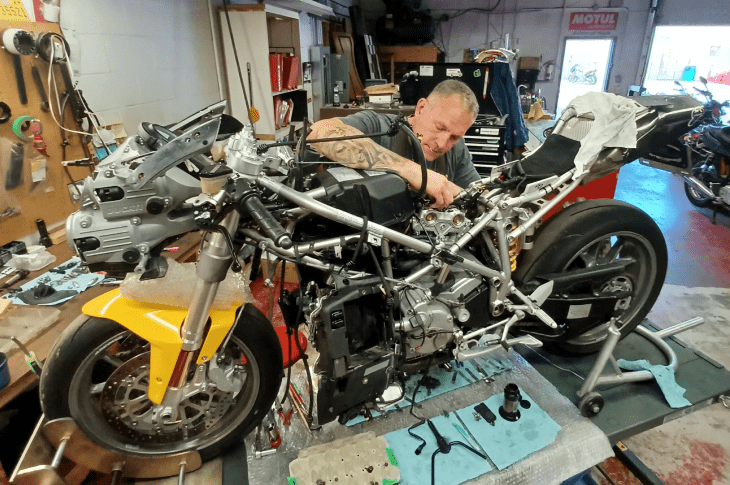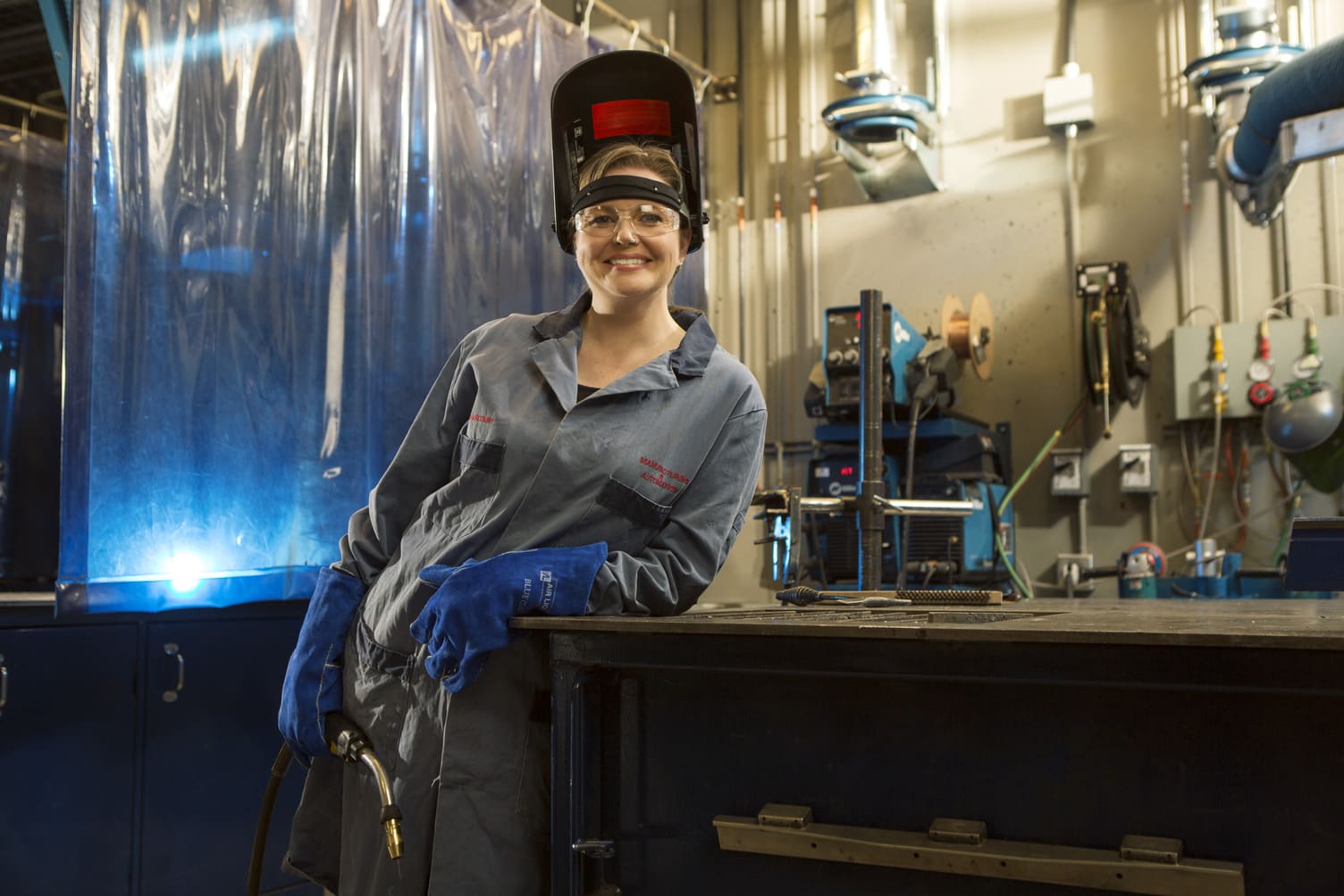On this page:
Overview
Learn the assembly, pre-delivery, inspection, maintenance, repair and restoration of motorcycles and other multi-wheeled, lightweight, all-terrain vehicles.
If you take pride in precise work, love motorcycling and like mechanical problem-solving, you will enjoy a career as a motorcycle mechanic.
As a motorcycle mechanic, you'll:
- assemble, inspect, repair and maintain motorcycles and other multi-wheeled lightweight all-terrain vehicles with astride seating and handlebar controls
- discuss complaints with customers or the service manager when a motorcycle or all-terrain vehicle is brought in for preventative maintenance or repair
- diagnose problems and locate failures with the electrical system, engine, powertrain, suspension or frame
- inspect the vehicle and use testing equipment
- dismantle, adjust or repair mechanical parts and systems
- perform routine maintenance such as cleaning, adjusting and replacing worn parts
- rebuild, replace and operate equipment such as valve seat cutters, chassis dynamometers, tire changers and computers.
To work in this trade, certification is required. This means that you must either be a registered apprentice working under the guidance of a certified journeyperson or be a certified journeyperson yourself.

I really enjoyed the hands-on part. Personally, I learn best when you explain it to me, demonstrate how it’s done, and then let me try. And you’re in a safe environment for that.
Jon James, Police officer turned apprentice

Motorcycle mechanics are skilled tradespeople who are self-motivated and enjoy working in a shop environment.
If you enjoy working with your hands and finding creative solutions to problems, you’ll excel in this line of work.
To succeed in this trade, you should:
- have mechanical aptitude
- have customer relations and computer skills
- take pride in your work
- have the strength, stamina and ability to use proper lifting techniques
- be willing to work long hours in the busy season
- enjoy work that requires precision and solving mechanical problems.
Upon successfully completing the required working hours and technical training periods, you'll be awarded a diploma in addition to journeyperson status by Alberta’s Apprenticeship and Industry Training.
This is a Red Seal Endorsed trade - a recognizable standard that allows tradespeople to work across Canada.
Careers and opportunities
Our graduates may work in the following occupations. Some careers require additional experience and education.
Associated National Occupational Classification (NOC) codes: 72423.
Apprenticeship training
The term of apprenticeship for a motorcycle mechanic is four years (four 12-month periods), including:
- a minimum of 1360 hours of on-the-job training and eight weeks of classroom instruction in the first and second years
- a minimum of 1420 hours of on-the-job training and six weeks of classroom instruction in the third and fourth years.
Year 1 | Period 1
You'll learn about workplace safety, equipment, materials and tools. You'll also cover equipment procedures, electrical theory and circuits, engine theory, circuits, wheels and tires, brake systems and assembly and pre-delivery.
Training length: 8 weeks
Year 2 | Period 2
You'll learn charging and starting systems, two-stroke top-end reconditioning, frames, suspensions, lubrication, cooling, fuels, clutches, primary drives and final drives.
Training length: 8 weeks
Year 3 | Period 3
You'll learn four-stroke valve train diagnosis and service, four-stroke top-end reconditioning, ignition and safety interlock systems.
Training length: 6 weeks
Year 4 | Period 4
Your final period of training will focus on fuel, exhaust and emission controls, troubleshooting systems, lower-end service and inspections and certification.
Training length: 6 weeks
Apprenticeship education performance
You must pass each section of the course and the AIT exam to succeed in apprenticeship education.
The passing grade for each period is no less than 50% in each course, with no less than a 65% average overall. A passing mark on each provincial exam and the interprovincial qualification (Red Seal Exam) is 70%.
View Alberta's Apprenticeship and Industry Training procedures
Training pathways
You can earn your journeyperson designation in one of the following ways.
The traditional training pathway begins with finding a job with an employer willing to indenture you as an apprentice. Once you are an apprentice, you will alternate between on-the-job training and educational periods.
You must apply for an apprenticeship through Alberta Apprenticeship and Industry Training before attending your first education period at SAIT.

Pre-employment pathway
SAIT’s Pre-employment Motorcycle Mechanic program prepares you to enter into an apprenticeship with hands-on skills. Upon successfully completing the program, you’ll qualify to challenge the first-year Motorcycle Mechanic apprenticeship exams.
Admission requirements
To enter an apprenticeship, you must have the educational qualifications required or recommended education for the trade to which you apply.
Entrance requirements are monitored and set by Alberta Apprenticeship and Industry Training.
Minimum requirements
Successful completion of the following courses:
- English 20-2
- Math 20-3
- Science 10
OR
A pass mark in all five Canadian General Educational Development (GED) tests
OR
Alberta Apprenticeship and Industry Training entrance exam.
Recommended requirements
Apprentices with an Alberta High School Diploma that includes the following courses:
- English 30-2
- Math 30-3
- Physics 30 OR Chemistry 30 OR Science 30
- Related career and technology studies (CTS) courses

MyTradeSecrets
Once you have begun working as an apprentice, you can attend SAIT to complete your technical training.
You'll register for technical training at SAIT on MyTradeSecrets or you can register by phone.
Transfer agreements
At SAIT, we have created transfer agreements with partner institutions to allow you to earn course credits toward your SAIT program based on your previously completed credentials.
Transfer Alberta search tool
Use the Transfer Alberta search tool to see all transfer agreements between Alberta post-secondary institutions (including those with the University of Calgary, Mount Royal University and Bow Valley College.)
Search transfer agreements in Alberta
There are no formal transfer agreements currently in place for this program.
Transfer options for graduates
When you have completed this program, you may continue your education at a partner post-secondary institution. These transfer agreements include partnerships within and/or outside of Canada.
Available intakes
Costs
2025/26 tuition and fees
The following costs are effective as of July 1, 2025.
This is a bring-your-own-device program with a standard computer hardware and software requirement. See the specific requirements on our computers and laptops page.
Books or modules, along with other items for classes, are approximately $600 per period.
We recommend you don't purchase books or modules ahead of time as they might be outdated by the time you attend classes, and they cannot be returned to the Bookstore.
Personal protective equipment (PPE) will be required for the program, which may be an additional cost to apprentices.

Funding options for apprentices
Apprentices get to learn while they earn, but there are still costs to consider. Many resources are available at SAIT and federally to help support apprentices.
Information sessions
Prepare for a strong start in your chosen program or get the details you need to decide your future path.
Our expert staff and faculty are ready to answer your questions and provide information about the following:
- What sets SAIT apart
- An introduction to the program and area of study
- Admission requirements
- Future career paths
- Information on the earning potential and graduate employment rates.
Contact
Have more questions?
Apprenticeship training and registration
Apprenticeship and Industry Training Client Services

Oki, Âba wathtech, Danit'ada, Tawnshi, Hello.
SAIT is located on the traditional territories of the Niitsitapi (Blackfoot) and the people of Treaty 7 which includes the Siksika, the Piikani, the Kainai, the Tsuut’ina and the Îyârhe Nakoda of Bearspaw, Chiniki and Goodstoney.
We are situated in an area the Blackfoot tribes traditionally called Moh’kinsstis, where the Bow River meets the Elbow River. We now call it the city of Calgary, which is also home to the Métis Nation of Alberta.
